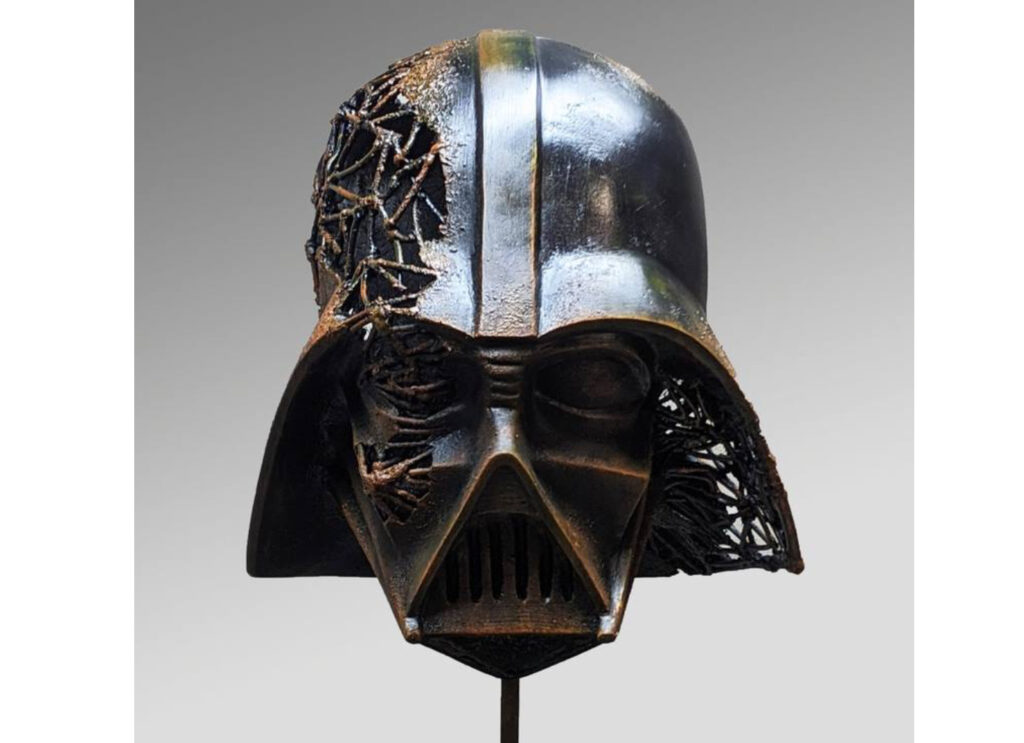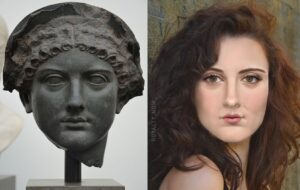In the stillness of form and shadow, Lost Sculpture by Ukrainian artist Roman Rabyk offers a paradox: a presence built on absence. Cast in resin and limited to only five editions, this sculptural work does not shout—it waits. With dimensions measuring 11.8 inches wide by 19.7 inches tall, it strikes a quiet figure in space. Yet what it lacks, what it intentionally withholds, gives it a gravity far beyond its physical size.
This is not a sculpture that explains itself. It doesn’t declare its subject with clarity. Instead, it invites viewers to interpret, to project, to sense something that has gone missing. In a time of conflict, upheaval, and loss—particularly from Rabyk’s home country of Ukraine—Lost Sculpture becomes more than a physical object. It becomes a reflection of collective uncertainty, cultural dislocation, and private longing.
The Artist: Roman Rabyk and the Language of Silence
Roman Rabyk is part of a growing generation of Ukrainian artists working at the intersection of conceptual minimalism and historical gravity. His practice, often grounded in form and material over overt symbolism, leans toward sculpture that feels lived-in—worn, wounded, but undeniably human.
Born and raised in Ukraine, Rabyk’s recent work carries an unspoken weight. His sculptures do not reference war directly, but they breathe in the background of geopolitical instability. Where some artists might render conflict in literal terms—explosions, uniforms, flags—Rabyk chooses ambiguity. He works in resin and cast forms not to replicate life, but to capture the spaces where life once stood.
Lost Sculpture fits squarely within this approach. It’s a work that demands contemplation, and rewards emotional projection.
Material Matters: Resin as Memory
At first glance, Lost Sculpture may seem stone-like, dense, even ancient. But its material—resin—suggests something more contemporary, even fragile. Resin is often used in industrial processes and design prototyping, but in the hands of an artist like Rabyk, it becomes poetic. It holds shape, but not forever. It mimics permanence, but contains no weight of marble or bronze.
Casting on resin adds another layer of interpretation. The act of casting implies a mold, an origin that has been reproduced—or lost. In this context, it evokes memory, duplication, and absence. It makes the sculpture feel like a relic not just of an object, but of a moment, a body, or a place now gone.
Resin is also deeply tactile. Light reveals its inconsistencies, its bubbles, its layers. As a viewer walks around Lost Sculpture, the light shifts. So does meaning.
The Form: Neither Figurative Nor Abstract
One of the most compelling aspects of Lost Sculpture is its resistance to easy classification. It is neither clearly figurative nor fully abstract. There are hints of structure—perhaps the curve of a shoulder, the echo of a head, the base of a torso—but they don’t resolve into clarity.
This ambiguity is its strength. Rabyk allows just enough visual information for viewers to see themselves—or someone lost to them—in the piece. It may be a guardian, a mourner, a witness. Or perhaps, more hauntingly, it is simply the outline of someone no longer there.
That tension—between recognition and uncertainty—is what makes the sculpture ache. It taps into the universal language of grief and disappearance.
Context Matters: Ukraine and the Unspoken Grief
To view Lost Sculpture without understanding the context of its country of origin would be to miss its emotional resonance. Ukraine, in recent years, has become a symbol of resistance, endurance, and cultural survival. Artists like Rabyk have been shaped by decades of post-Soviet identity negotiation and, more recently, the trauma of war.
But Rabyk doesn’t preach. He doesn’t wave a flag. Instead, his work mourns quietly. It speaks to what is lost—not just in war, but in migration, in memory, in time. The limited edition of five makes that mourning more intimate. Each piece becomes a fragment of something broken, preserved across different spaces, scattered like emotional artifacts.
Sculpture as Witness
Art often aims to capture beauty. But Lost Sculpture stands as a witness. It doesn’t ask to be admired. It asks to be considered. It’s not dramatic, but it’s not passive either. It occupies space in a way that reminds us we all leave impressions—even in absence.
Standing nearly 20 inches tall, it’s human-scaled. Not towering, not miniature. Just large enough to confront, just small enough to feel personal. It invites you to walk around it, to look at it from every angle. And no matter where you stand, it refuses to fully reveal itself.
That’s the experience of loss, captured in physical form.
Limited Edition: The Intimacy of Five
The choice to produce Lost Sculpture in a limited edition of only five makes a powerful statement. This is not a mass-produced piece. It’s rare. Specific. Each of the five editions carries a responsibility—not just to be displayed, but to be held in trust. To be seen not as decoration, but as testimony.
There’s something profound in that scarcity. It transforms the sculpture from a product into a relic. For collectors, curators, or private viewers, owning one is not just acquisition—it’s participation in something larger. In history. In art. In human experience.
Contemporary Casts and the Long History of Absence
Casting has a long tradition in sculpture—from the bronze statues of antiquity to modernist experiments in plaster and resin. But Rabyk reclaims casting not to replicate form, but to memorialize loss. His molds feel like negative space—the memory of something no longer present.
In that way, Lost Sculpture aligns with other artists working with the poetics of absence—Rachel Whiteread, Doris Salcedo, or even the shadows left behind in Hiroshima. These are works that suggest the trace of trauma, the edge of identity. Rabyk joins this lineage, quietly but confidently.
Aesthetic and Placement: The Sculpture in Space
When placed in a gallery or private setting, Lost Sculpture transforms its environment. It doesn’t dominate a room, but it alters it. The silence of the piece makes the surrounding space more visible, more sensitive.
Its neutral tones and matte finish allow it to shift between modern interiors and more classical settings. But wherever it stands, it carries stillness. In a white cube gallery, it becomes a pause. In a home, it becomes a question. In a museum, it becomes a line between past and present.
Flow
Roman Rabyk’s Lost Sculpture is not about forgetting. It is about how we carry what’s missing. It’s a physical meditation on the things we’ve misplaced—people, memories, identities—and how those absences shape who we are.
In its form, it suggests what cannot be said. In its material, it speaks to the fragility of memory. In its edition, it honors the specificity of individual experience. And in its silence, it tells a story too large for words.
Art, at its most powerful, does not give us answers. It gives us something to sit with. Lost Sculpture does exactly that. It doesn’t explain. It doesn’t comfort. But it doesn’t look away.
No comments yet.








